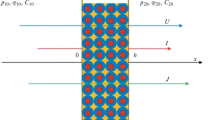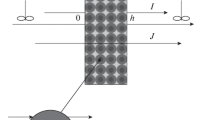Summary
The osmotic flow through a porous charged membrane separating electrolyte solutions of different concentrations but at a constant temperature is studied theoretically, using a capillary model for the membrane. The assumptions used are that theDebye-Hückel approximation is applicable for the ion distribution in the double layer formed near the fixed charges on the capillary wall, and that the thickness of the double layer is much smaller than the capillary radius. The steady state solutions of the differential equations derived are obtained subject to the external conditions that the concentrations of the outer solutions are maintained constant and no pressure head is applied across the membrane. It is shown that the volume rate of osmotic flow is the sum of two terms, one arising from the fact that the membrane is electrically charged and the other being independent of the membrane charge and thus observable commonly both in charged and uncharged membranes. The former corresponds to whatGrim andSollner have referred to as the true anomalous osmosis. The plot of this electric part of osmosis against the logarithm of the concentration of one outer solution gives a bell-shaped curve, when the concentration ratio of the outer solutions is fixed. This theoretical curve follows well theGrim-Sollner data of the true anomalous osmosis for various aqueous electrolyte solutions. The true anomalous osmosis is an electro-osmotic flow caused by the electric field which is set up inside the membrane so that no net transport of electric charge occurs from one solution compartment to the other. The dependence of the electroosmotic coefficient on salt concentration is responsible for the characteristic behavior of the osmotic flow rates through charged membranes.
Zusammenfassung
Der osmotische Flu\ durch eine poröse geladene Membran, die die Elektrolytlösungen verschiedener Konzentrationen, doch von konstanter Temperatur trennt, wird theoretisch untersucht unter Anwendung eines Kapillarmodells für die Membran. Die verwendeten Annahmen sind die, da\Debye-Hückel-NÄherung für die Ionenverteilung in der Doppelschicht, die sich in der NÄhe der fixierten Ladungen an der Kapillarwand bildet, verwendet werden kann und da\ die Dicke dieser Doppelschicht viel kleiner als der Kapillarradius ist. Die stationÄren Lösungen der abgeleiteten Differentialgleichungen werden unter der Bedingung erhalten, da\ die Konzentrationen der Äu\eren Lösungen konstant sind und keine Druckdifferenz über die Membran existiert. Es wird gezeigt, da\ die Volumendurchtritts-geschwindigkeit des osmotischen Flusses aus zwei Anteilen besteht, der eine auf Grund der Tatsache, da\ die Membran elektrisch geladen ist, der andere unabhÄngig von der Membranladung, und da\ gewöhnlich beide in geladenen und ungeladenen Membranen beobachtet werden können. Erstere entspricht dem, wasGrim undSollner als wahre anomale Osmose bezeichnen. Die Auftragung dieses elektrischen Teils gegen den Logarithmus der Konzentration der einen Äu\eren Lösung gibt eine Glockenkurve, wenn das KonzentrationsverhÄltnis der Äu\eren Lösungen fixiert ist. Diese theoretische Kurve folgt gut den Ergebnissen vonGrim-Sollner für die wahre anomale Osmose für verschiedene wÄ\rige Elektrolytlösungen. Die wahre anomale Osmose ist ein elektro-osmotischer Strom auf Grund des elektrischen Feldes, das innerhalb der Membran aufgebaut wird, so da\ kein Nettotransport elektrischer Ladungen von einer Lösung zur anderen stattfindet. Die AbhÄngigkeit des elektro-osmotischen Koeffizienten von der Salzkonzentration ist für das charakteristische Verhalten osmotischer Flie\geschwindigkeiten durch die geladene Membran verantwortlich.
Similar content being viewed by others
References
Dutrochet, M., Ann. Chim. Phys.60, 337 (1835).
Loeb, J., J. Gen. Physiol.4, 463, 621 (1922), etc.
Bartell, F. F. andO. E. Madison, J. Phys. Chem.44, 244, 593 (1920), etc.
Sollner, K., Z. Elektrochem.36, 36, 234 (1930); J. Phys. Chem.49, 47, 171, 265 (1945), etc.
Schlögl, R., Z. physik. Chem. N. F.3, 73 (1955).
Kedem, O. andA. Katchalsky, J. Gen. Physiol.45, 143 (1961).
Kobatake, Y., J. Chem. Phys.28, 442 (1958).
Grim, E. andK. Sollner, J. Gen. Physiol.40, 887 (1957).
Carr, C. W. andK. Sollner, J. Electrochem. Soc.109, 616 (1962).
Kobatake, Y. andH. Fujita, J. Chem. Phys.40, No. 8 (1964).
Kobatake, Y. andH. Fujita, J. Chem. Phys.40, No. 8 (1964).
Teorell, T., Exptl. Cell Research, Suppl.3, 305 (1953); J. Gen. Physiol.42, 831, 847 (1959); Biophys. J.2, 27 (1962); Discussions Faraday Soc.21, 9 (1956).
Author information
Authors and Affiliations
Rights and permissions
About this article
Cite this article
Kobatake, Y., Fujita, H. Osmotic flow in charged membranes. Kolloid-Z.u.Z.Polymere 196, 58–64 (1964). https://doi.org/10.1007/BF01500027
Received:
Issue Date:
DOI: https://doi.org/10.1007/BF01500027




